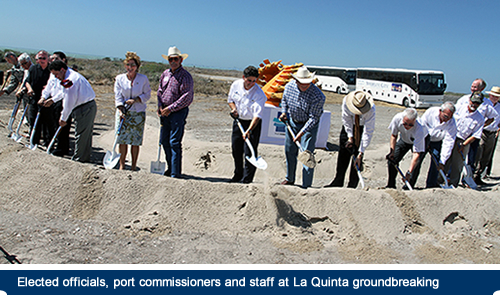
September 26, 2011
Several hundred representatives of communities surrounding Corpus Christi Bay gathered to celebrate the next step in expanding the port-related industrial infrastructure in San Patricio County. A parade of enthusiastic speakers pointed to a promising future of new North Shore industrial development.
The festivities helped kick off a dredging project that will extend the federal La Quinta Ship Channel by 1.4 miles and will include a new Portland turning basin. 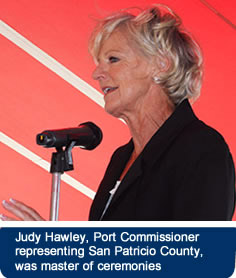
The Army Corps of Engineers has awarded a $33.5 million contract for the channel dredging and a $7.5 million contract for a related ecosystem restoration project at the edge of Corpus Christi Bay near Ingleside on the Bay. Project costs are being shared by the Port of Corpus Christi Authority, the non-federal sponsor, and the Federal Government.
Channel dredging will begin in late 2011 and all project elements are scheduled for completion in mid-2013. This work will create 7,300 feet of new deepwater ship channel frontage in San Patricio County.
At the west end is 3,850 feet of frontage on 1,100 acres of developable property purchased by the port authority in 1998. This property makes up the La Quinta Multipurpose Facility site, acreage with limited industrial or commercial potential without extension of the ship channel.
The port authority has persisted over the years in pursuing the channel extension and additional infrastructure necessary to develop the site as a marine terminal and industrial location with excellent highway, rail and waterway access. A portion of the site may be built out as a container handling terminal.
The San Patricio Municipal Water District will provide industrial and potable water to new operations as they are added to the La Quinta development site and surrounding industrial properties. The Water District has transmission facilities on site and the water treatment complex is located two miles to the east.
The extended ship channel will also directly serve 3,500 feet of frontage on property owned by Sherwin Alumina. This property was permitted in 2005 for a Cheniere liquefied natural gas (LNG) import terminal. (Two other LNG terminal sites on La Quinta Channel were also permitted but not built). Very large shale gas discoveries on the U.S. mainland – including the massive Eagle Ford Shale west of Corpus Christi – have changed the natural gas market, forcing the reassessment of all new LNG terminals. In South Texas this new energy production has triggered new pipeline and marine terminal construction to move Eagle Ford crude and gas condensate to market.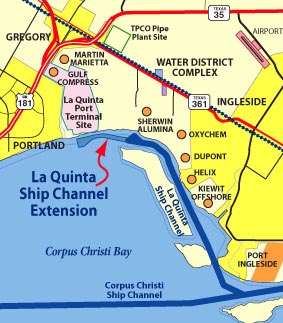
When the La Quinta Channel Extension Project is complete it will be the first time the Corpus Christi Ship Channel system has been extended since 1960, the year dredging was completed to the Viola Turning Basin located 8.5 miles west of the Harbor Bridge. And because of geography and existing development it will likely be the last linier extension of either the Corpus Christi Inner Harbor or the La Quinta Channel.
La Quinta Channel was first completed in 1952 to serve two Reynolds Metals plants, attracted to the north shore of Corpus Christi Bay by cheap natural gas, available water and ready access to Jamaican bauxite. Originally 35 feet deep, it was dredged to 45 feet in the 1970s. DuPont, OxyChem, Air Liquide, Kiewit Offshore Services and Helix Energy have all made investments to take advantage of the deepwater channel.
The La Quinta Extension is an element of a federal channel improvement project that has been in the planning since the late 1980s. Federal feasibility and environmental studies were done between 1990 and 2003. During that time dozens of people helped shape plans for beneficial use of dredge material to be produced at each stage of dredging and subsequent maintenance. The Corps of Engineers issued the final record of decision permits covering the channel system in 2006.
In 2007 Congress authorized the deepening the entire Corpus Christi Ship Channel system to a depth of 52 feet (mean low tide) from the current 45 feet. Initial federal funds were appropriated in 2009. The authorized project also includes extension of La Quinta Channel, widening of the channel from Port Aransas to the Harbor Bridge, adding barge shelves across Corpus Christi Bay and building a set of ecosystem restoration features to protect wetlands and seagrass.
A 200-acre upland dredge material placement site completed on the La Quinta property in 2010 was the first element of this process. When it is eventually filled the leveed area will be reshaped and planted to create a vegetated buffer on the west side of the terminal property.
More immediately, soil from the channel will be used to construct Beneficial Use Site 6 (below) which will contain the material, support shallow water seagrasses and provide a breakwater protecting the turning basin, channel and docks from wave action produced by the prevailing southeast wind across the wide bay.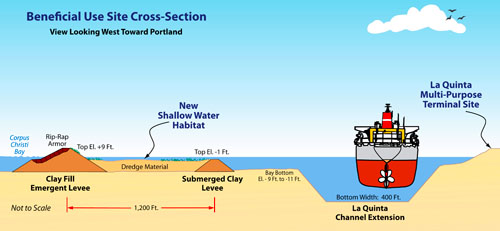
The breakwater will be rock armored and will extend 9 feet above mean low tide. The bay is approximately 10 feet deep in this area. The 190 acres behind the breakwater will be filled to a point that creates shallow water habitat 1 to 2 feet deep. It will provide areas suitable for planting and colonization by submerged aquatic vegetation and for marsh and upland habitat development.
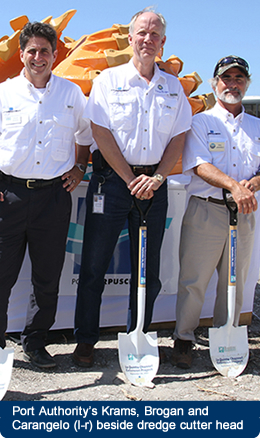 The second ecosystem restoration project site is five miles to the southeast near Ingleside Point. It consists of 2,200 feet of offshore breakwater and 1,050 feet of shoreline stabilization that will protect 45 acres of existing submerged aquatic vegetation.
The second ecosystem restoration project site is five miles to the southeast near Ingleside Point. It consists of 2,200 feet of offshore breakwater and 1,050 feet of shoreline stabilization that will protect 45 acres of existing submerged aquatic vegetation.
A port authority staff team lead by Deputy Port Director Frank Brogan, P.E., has coordinated the 22-year process of getting the federal channel improvement project authorized, permitted, designed, partially funded and started. This has been done in concert with congressional action and work by the Army Corps of Engineers.
David Krams, P.E., the port's manager of channel development, has been guiding the step-by-step process since 1997. Meeting with resource agencies and stakeholders began in the early 1990s and included consultation with community leaders and public meetings to develop possible issues to be addressed during the feasibility study and environmental impact statement phase.
Paul Carangelo, the port's coastal environmental planner, has been involved throughout. His duties include coordinating the activities of the project's Beneficial Use Plan Implementation Group which consists of technical personnel from federal and state resource agencies. The panel was instrumental in guiding the development of the project's dredge material management plan during the permitting process a decade ago.
More information about efforts to develop the La Quinta Multipurpose Facility is available in an earlier post HERE.









